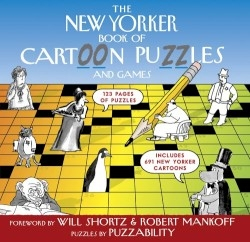The New Yorker Book of Cartoon Puzzles and Games
Cartoons and puzzles go together naturally. An element of “solving” goes into enjoying a cartoon—there’s a twist to be understood, and when the viewer “gets” it, there’s a rush of pleasure, a burst of laughter. That same “aha” moment happens in deciphering puzzles—a flash of joy experienced when the pieces snap together in the mind. Will Shortz, New York Times puzzle editor and NPR’s puzzlemaster, jokingly calls that “the Cruciverbal Pleasure Center.”
Shortz and Bob Mankoff, cartoon editor of The New Yorker, wrote the foreword to this book as a witty conversation. Mankoff explains why the two media dovetail so nicely: “Puzzles and cartoons are both respites from the world. Cartoons represent freedom—they’re a relief from the crushing monotony and rigidity of the world. Puzzles are a respite from chaos.”
Readers will find plenty of respite and distraction in the eighty-three puzzles in this book, all constructed using cartoons from The New Yorker magazine. The games range from quick, amusing caption match-ups to diabolically complex acrostics, created by the authors, who form a puzzle-writing company called Puzzability. They produce puzzles for websites, game shows, newspapers, magazines, and other media, and have previously published a book of celebrity crosswords. For this volume, they scoured The New Yorker for cartoons to manipulate into clever puzzles, from word ladders to jumbles, cipher alphabets to classic crosswords with a cartoon complexion.
One page displays five drawings, each with a five-letter word missing from its caption. Those missing words fit perfectly into a word square, reading the same down and across. To solve it, one works back and forth between grid and cartoons. Putting in the final letter will likely cause the solver to laugh out loud.
Another puzzle contains thirteen captionless cartoons showing official-looking desks. Each desk sports a blank sign, with the missing words listed in an accompanying box. The reader matches the signs to the desks, “solving” the cartoons. There are puzzles with themes, like cartoons about clowns or presidents.
For the frustrated and the impatient (and those who solve puzzles by looking at the answers and deciding whether or not they could have gotten them), answers are provided. Even the front page of that section offers a cartoon: two panels, one labeled “Before,” displaying an untouched crossword, and one labeled “After,” in which the entire grid is black. For devotées of New Yorker cartoons, there’s an index of artists (some cartoonist stars, like Charles Barsotti, rate a puzzle of their very own).
The authors eloquently define their product: “This is a puzzle book until you solve it—then it’s a book of New Yorker cartoons with pencil marks all over it.” Any family members who complain that the book has been scribbled in should be told to get their own copy.
Reviewed by
Karen McCarthy
Disclosure: This article is not an endorsement, but a review. The publisher of this book provided free copies of the book to have their book reviewed by a professional reviewer. No fee was paid by the publisher for this review. Foreword Reviews only recommends books that we love. Foreword Magazine, Inc. is disclosing this in accordance with the Federal Trade Commission’s 16 CFR, Part 255.

